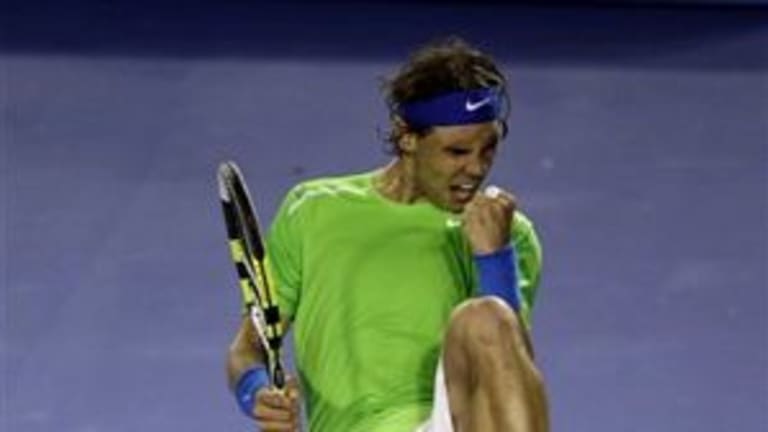MELBOURNE—They say the best players know how to peak for their most important matches. It’s hard to find any better evidence of that than Rafael Nadal’s 6-7 (5), 7-6 (6), 6-4, 6-3 quarterfinal win over Tomas Berdych at the Australian Open last night. Nadal began the evening looking like the second best player on the court, and ended it with some of the most audacious tennis of his Hall of Fame career. It was like he knew he was going to be facing Roger Federer in the next round or something. Between the start and the finish, we got the best and most eventful match of the Aussie Open thus far.
It was Berdych who was sharper at the beginning. Once upon a time, for a few months, the 6-foot-5 Czech had Nadal’s number, and while he had lost their last 10 meetings, he remains the type of opponent who can give Nadal fits: tall, with flat strokes and a two-handed backhand that he can use to take Rafa’s high-bouncing forehands on the rise. He did that extremely well for two sets tonight, especially during the match’s first key moment, with Nadal serving down 5-6 in the first.
Berdych jumped out of his shoes during the first three points. He started with a crosscourt backhand pass for 0-15, followed that with an inside-out forehand return winner for 0-30, and came back with another penetrating return for 0-40. On the next point, he lined up a forehand down the line and drilled it into the tape. That’s when something seemed to click with Nadal; his game, and attitude, began to intensify. On the next point, the two players ran each other through a 29-shot rally before Nadal ended it with a no-look forehand flick passing shot at the net that left Berdych running helplessly in the other direction.
Nadal, wired up and swinging with growing confidence and greater abandon than he had in his first four matches, went on to hold and reach a tiebreaker. But it wouldn’t be enough to earn him the set. At 5-5 in the breaker, Nadal watched as a Berdych ground stroke sailed long, then waited in vain for a call. (There was a lot of waiting in vain for calls in this poorly officiated match; Hawk-Eye got a workout). When none came, Rafa began to move for Berdych’s next shot, and then signaled for a challenge—too late. It was the move that did Rafa in; if he had stood his ground and raised his arm, he might have been OK. The ball was out, but it was Berdych’s set point rather than Nadal’s, and he capitalized.
The momentum reversals were only getting started. Nadal broke Berdych early in the second, but after two love holds took him to 5-3, his serve deserted him. Three times he spun in weak second deliveries, three times Berydch, who was still hitting and moving extremely well, buried returns. He broke and the two players proceeded to another tiebreaker. Again Nadal earned a lead, and again Berdych hit his way out of it. With one more forehand winner, the Czech reached set point at 6-5 for a two-set lead. He played a strong point, scrambled to the net, got a difficult but makeable backhand volley with an open court, and put it into the alley. A few minutes later, instead of being up two sets to none, Berdych was tied at a set a piece, starting from scratch, with a leaping Rafael Nadal on the other side of the net.
Berdych hung in gamely until the end, but Nadal had the wind at his back, and he got better with virtually every game. He broke Berdych with a dipping return for 3-2, and from there he began to stretch Berydch along the baseline. Up 5-3, Nadal hit a wild reverse forehand return and followed it with a jumping, side-spinning forehand pass that looked a lot like the shots he was trying, and making, in his greatest match here, his 2009 semifinal against Fernando Verdasco.
The similarities with that match began to mount as Nadal grew in confidence in the fourth. He started the set with another running hook forehand pass that nearly curled around the net, and he finished it taking full cuts at Berdych’s first serves, sending the ball back over the net faster than it had come in. For much of the match, Nadal set up to return somewhere just inside the Yarra River, but he crept in and out as the night wore on, and finished close to the baseline, reflexing away. Nadal would end the match with 57 winners against 30 errors.
In the final game, sideline commentator Roger Rasheed said that Rafa was “sending good messages to himself.” It’s a weird statement, but you could see what he meant. Nadal was past nerves, past tactics, past the pressure of the moment, the danger of the opponent, or playing the percentages. As they were at the end of that Verdasco match, Rafa’s eyes were wide with the emotion of the moment when he stood to return serve up 5-3 and 0-40. Until that point, Nadal had struggled with returns on break points. This time, instead of moving back, he ran forward and, seemingly without stopping, drilled a forehand to end it.
The match that followed Nadal's win over Verdasco in 2009 here was a classic five-set final with Roger Federer. It was the only time they've faced each other at the Australian Open. They'll do it again Thursday.
—Steve Tignor

